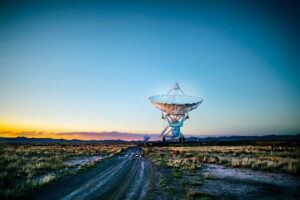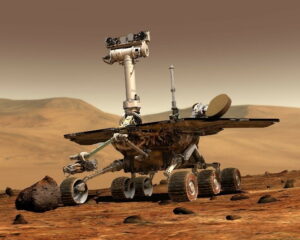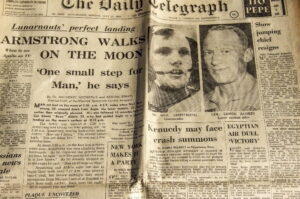 We might think of space as the endless, dark vastidity which of course, in a certain way, it is, but we, in fact all use space very frequently, often without knowing it. Whether we check the weather forecast, use the television, the navigation system in our car or making financial transactions, it all comes down to the everyday use of space.
We might think of space as the endless, dark vastidity which of course, in a certain way, it is, but we, in fact all use space very frequently, often without knowing it. Whether we check the weather forecast, use the television, the navigation system in our car or making financial transactions, it all comes down to the everyday use of space.
What is more, weather forecast today is provided by the satellite system as a result of the gigantic international diplomatic collaboration between the United States, Russia, China, Japan and Europe; launched during the Cold War!
Space equals diplomacy, since there is no so-called owner of space, making it an absolute necessity to cooperate and communicate for all nations participating in space programs to any extent. Today, there are over 100 countries with their very own space programs: negotiations are at their peak as the question of the USSF (United States Space Force) is rising up again, thanks to the recent Biden-Harris administration.
 On February 18, 2021, NASA’s Mars rover, Perseverance successfully landed on the surface of the Red Planet. Quite a historic moment, following years of international research and cooperations. The official announcer of the landing, also rather historic, was Swati Mohan, an Indian-American woman. According to several reports on the event, her role represents just how far NASA has come in embracing diversity among employees. There has definitely been a change in the attitude towards women at NASA, yet women still only make up about a third of NASA’s workforce. Up until 1978, almost 10 years after the moon landing, only white men were selected to attend any kind of mission or allowed to take part in research in space.
On February 18, 2021, NASA’s Mars rover, Perseverance successfully landed on the surface of the Red Planet. Quite a historic moment, following years of international research and cooperations. The official announcer of the landing, also rather historic, was Swati Mohan, an Indian-American woman. According to several reports on the event, her role represents just how far NASA has come in embracing diversity among employees. There has definitely been a change in the attitude towards women at NASA, yet women still only make up about a third of NASA’s workforce. Up until 1978, almost 10 years after the moon landing, only white men were selected to attend any kind of mission or allowed to take part in research in space.
Space matters. It is clear, since the outbreak of the Space Race, one of the most complex series of diplomatic events in human history. Nevertheless, when it is talked about, the focus is mostly on the never-ending conflict between the United States and the Russian Federation (formerly the Soviet Union). However, in 1968, at the height of the Cold War, The States and the then Soviet Union had to reach an agreement when both of them were launching space missions (the Zond 5) at the same time: a crash would have been inevitable unless the negotiations. It is a lesser known fact that while the US spacecraft carried actual human astronauts, attempting to orbit around the Moon, the Soviet Union’s vehicle contained two tortoises, who both also returned safely to the Earth!
Many consider the Space Race the fiercest force competition of all time: diplomacy in such strained circumstances is remarkable. Without diplomacy in space, lines of collisions would eventually cause cascade effets, much like a pileup accident in a motorway: except that the crashed vehicles couldn’t be removed and others couldn’t be stopped to crash into the pile. In other words, doing without space and most importantly, space diplomacy is quite simply not an option on Earth. Even when certain countries are pushing apart in political or economical matters, it is crucial to still cooperate and move forward with space regulations and laws.
The making of the ISS (International Space Station) is a brilliant example of the statement above: it took the joint participation of 103 countries, many of which are not exactly on speaking terms diplomatically speaking, for 18 years before the official launch in 1998. The ISS has been the most politically complex space exploration program ever undertaken, and the most powerful example of international cooperation in the history of mankind, experts later admitted. We might as well call it one of the most important and pioneering diplomatic events of all time.
 Another, probably the most famous milestone in the history of space exploration is the moon landing, on July 20, 1969. After the three US astronauts (Neil Armstrong, Buzz Aldrin and Michael Collins) flew back to Earth after successfully landing on the lunar surface, they completed a world tour in 38 days, visiting 22 countries. Much like busy diplomats and politicians these days -well, definitely before the pandemic. The tour included a visit to Buckingham Palace, where the astronauts were welcomed by the Royal Family of Windsor, led by Her Majesty, The Queen of course. They got a welcoming committee just like important dignitaries from around the world: after all, each and every astronaut can be considered a diplomat, a diplomat from Planet Earth!
Another, probably the most famous milestone in the history of space exploration is the moon landing, on July 20, 1969. After the three US astronauts (Neil Armstrong, Buzz Aldrin and Michael Collins) flew back to Earth after successfully landing on the lunar surface, they completed a world tour in 38 days, visiting 22 countries. Much like busy diplomats and politicians these days -well, definitely before the pandemic. The tour included a visit to Buckingham Palace, where the astronauts were welcomed by the Royal Family of Windsor, led by Her Majesty, The Queen of course. They got a welcoming committee just like important dignitaries from around the world: after all, each and every astronaut can be considered a diplomat, a diplomat from Planet Earth!




